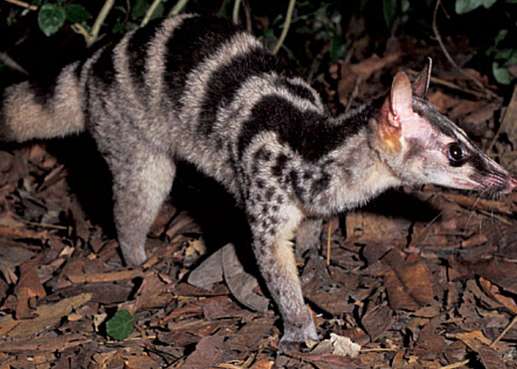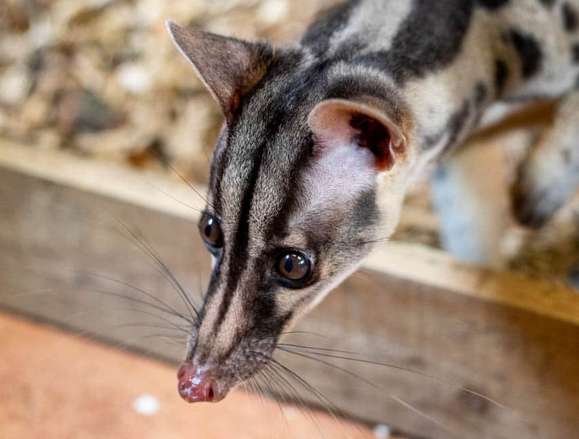The Jinping Watershed Nature Reserve located in southeastern Yunnan Province is a national nature reserve. It has the largest pristine mountain moss evergreen broad-leaved forest in China, and it is very well preserved, so it can be imagined that We know how superior the natural environment of Jinping Watershed Nature Reserve is. It is one of the areas with the highest biodiversity in Yunnan Province and even in the country.

The protected area mainly consists of forest ecosystems Mainly, it has a marginal tropical humid climate, with mild climate all year round, abundant rainfall, and rich animal and plant resources. Among the national first-level protected animals are loris, black gibbons, monitor lizards, etc.
The superior natural environment provides a place for many wild animals to survive. Many rare and exotic animals thrive here, so in the Jinping Watershed Nature Reserve, you can see many extraordinary animals. Strange animals.
Recently, when the staff of the Jinping Watershed Nature Reserve were checking and sorting out the data captured by infrared cameras, they were pleasantly surprised to find that the infrared cameras installed in the Shillong Mountain area captured multiple images of the activities of the silk civet. , which inevitably made the staff excited. Because onyx cats are very rare, their numbers are rare and they are only found in Yunnan and Guangxi in China.
The "silky cat" with a head like a mouse and a body like a cat
Judging from the footage, it was late at night when an animal like a wild cat suddenly broke in In front of the camera, I saw it looking around, seemingly looking for food. Sure enough, after a while, it found something to eat in a place full of dead branches and leaves. After eating the delicious food, it quickly jumped out of the screen.
From the picture, this mysterious animal looks very strange, with a pointed mouth and round ears. The whole head looks like a mouse, but its body looks like a mouse. cat. In fact, this weird-looking mysterious animal is called the long-jawed civet, and people prefer to call it "silky civet".
As you can see, the head of the civet cat is like a mouse, but its body is like a cat. It belongs to the civet family, smaller than the big civet, larger than the small civet, and weighs 2-4 kg in adulthood.
The base color of the fur on a civet cat is generally light yellow or light white. There are three black vertical stripes on the head, an "eight" pattern on the shoulders, and four broad black horizontal spots on the back. There are spots of varying sizes on the sides, there are dark brown patches at the base of the tail, and the rear two-thirds of the tail are dark brown.
The biggest feature of the onyx cat is its head.The bones are extremely specialized, the snout and nose are particularly low, and the jaw bones are abnormally elongated. This is how the name "long-jawed civet" comes from.
Live alone and often appear at night
Only civets mainly live in forests below an altitude of 500 meters. They have very high requirements for the environment. Not all forests are suitable for them. Survive. Generally speaking, their residence should be close to water sources and have dense vegetation, preferably virgin forests.

Like other animals of the civet family , Onyx cats also live alone. They will build caves under thick tree trunks or among dense bushes. The caves are generally relatively hidden. Of course, some directly use natural tree holes, rock holes or earth holes.
Both males and females have scent glands, but they are not too developed. The secretions of the scent glands help them resist predators.
Civets are animals that appear to be active at night. In fact, this is true. They are nocturnal and usually hide in caves to rest during the day and come out to be active in the evening.
Night is the peak time for them to forage. The civet mainly feeds on the ground. Its main food is some small invertebrates, and earthworms are its main food. However, the civet cat has a strong ability to climb trees, so it occasionally forages for food in trees.
For example, you can eat some fruits and hunt small vertebrates such as squirrels. Due to the structure of the civet's mouth, there is a large gap between their incisors, canines and molars, making it easier to bite prey.
The number is rare and people don’t know much about it
The main distribution range of the onyx civet is in Southeast Asia, such as Laos and Vietnam. It is rarely distributed in my country, mainly in Guangxi and Yunnan In some protected areas with superior natural ecology, the number is so rare that before 2016, many biologists had never seen a real, lively and energetic civet.
After the founding of the People's Republic of China, the early wildlife census was conducted in a very simple way, which was to go to the leather purchasing station to see how many kinds of animal skins there were.
According to records in the Therapeutics of South China, staff at the acquisition stations in Pingbian, Yunnan and Longzhou, Guangxi discovered civets, such as civets, which have a long and narrow face and a snout. It protrudes forward and is named "long-jawed civet". Because there are 4 obvious horizontal spots on its back, it is also called "Striped Civet".
The onyx civet is a very mysterious animal. On the one hand, it is because of its narrow distribution range and small population size.It is rare in quantity; on the other hand, it is alert in character, hiding day and night, and is not seen by people. Therefore, there is not much research on the civet cat so far, and the understanding of its habits is not very deep.

This situation existed before 2016 It is very serious. Domestic animal experts are basically at a "zero" state of research on it. After 2016, because they were photographed one after another, the situation improved. Nowadays, thanks to the widespread use of infrared cameras, it is no longer difficult to capture images of wild civets.
How rare are onyx cats in our country? Let’s put it this way, Yunnan Province is a place with very rich wildlife resources in my country, and the distribution of onyx civets in Yunnan is also very limited. They are only found in Malipo, Pingbian, Maguan, Jinping, and this time in The images of civet activity captured in the Jinping Watershed Nature Reserve are currently the northernmost point where we have found their activities.
I believe that as the ecological environment continues to improve, the number of onyx cats will increase and people will conduct more in-depth research, and more aspects of onyx cats will be revealed to us.